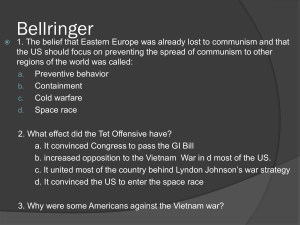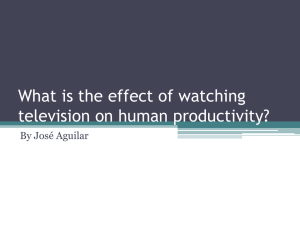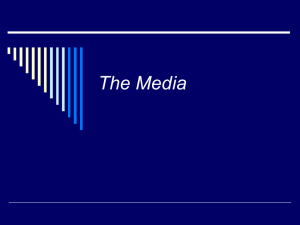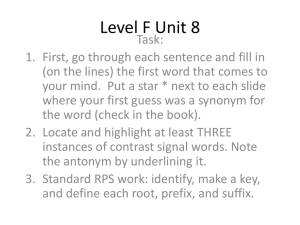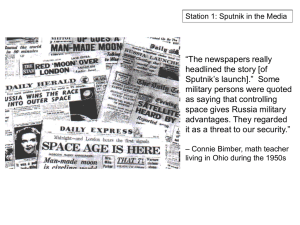Standard 21
advertisement
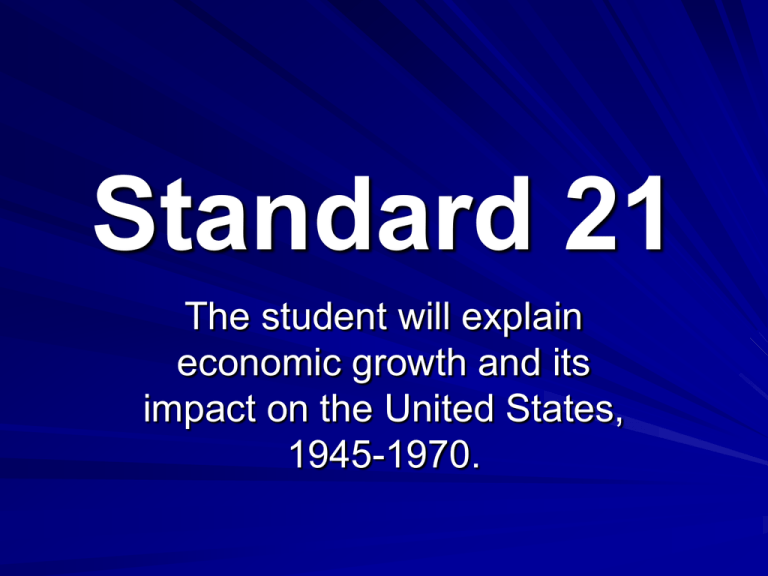
Standard 21 The student will explain economic growth and its impact on the United States, 1945-1970. A The Baby Boom An estimated 78.2 million Americans who were born between 1946 and 1964. Levittown Levittown was the first truly mass-produced suburb and is widely regarded as the archetype for postwar suburbs throughout the country. (Impact of the car) It was a reaction to the houses required by all of the growing families from the Baby Boom. Levittown provided affordable houses in what many residents felt to be a congenial community, critics attacked its homogeneity, blandness, and racial exclusivity Interstate Highway Act Dwight D. Eisenhower signed this bill into law. Appropriating $25 billion for the construction of 41,000 miles of interstate highways over a 20-year period. Eisenhower argued for the highways for the purpose of national defense. One result of building the roads made commutes between urban centers to suburbs much quicker, furthering the flight of citizens and businesses. Why was the 1947 suburban development Levittown of importance? A. B. C. D. Levitt was a well-known developer. Other suburban developments failed. It signified a trend in American society. It was the only suburban development for years. Someone born in 1948 would be considered a A. B. C. D. GI Baby Boomer Sputnik Member of the space race The 1956 National Interstate and Defense Highway Act reads in part, “It hereby declared to be essential to the national interest…” What was an important concern of this legislation? A. B. C. D. To enhance rural life To add to the economy of the cities To provide good roads for suburban living To create a system of roads for the efficient transport of military troops What was the significance of Levittown? A. B. C. D. It showed the need for a working GI Bill. It sparked the growth of American suburbs. It was the center of American industry. It was the site of the Kennedy-Nixon debates. A US army soldier returning home after WWII to find that he could get a loan and buy an affordable new home in the suburbs would most likely owe a debt of gratitude to A. B. C. D. HUAC and Joseph McCarthy. “Reaganomics”. The New Deal. The GI Bill and William Levitt. People born in the US in the first few years following WWII became known as A. B. C. D. Post-war citizens. Population surgers. Conservatives. Baby-boomers. B The Kennedy/Nixon Debate This was the first televised debate in American history. The first debate for the 1960 election drew over 66 million viewers out of a population of 179 million, making it one of the mostwatched broadcasts in U.S. television history. Kennedy is generally considered to have won the debate. Nixon appeared worse than Kennedy on television, with poor makeup, a haggard appearance. The televised debates were thought to be the difference in what was an extremely close election. The Civil Rights Movement Television brought the violence of Southern police against peaceful African American protesters into the living rooms of America. These visuals helped motivate White America to stop segregation and work towards racial equality. What had a major impact on the outcome of the 1960 Kennedy-Nixon debates? A. B. C. D. Political platforms Radio Computers Television What effect did news coverage of the civil rights movement have? A. It resulted in new Jim Crow legislation in the South. B. It forced the federal government to place restrictions on the media. C. It increased pressure on the federal government to pass civil rights legislation. D. It reduced the momentum of the civil rights movement. In what way did television greatly impact culture in the ‘60s and ‘70s? A. B. C. D. Its popularity made radios obsolete. It ended social and political strife by promoting unity. It led to a lack of interest in social issues and concerns because more and more people stayed home to watch television rather than become involved in causes relevant to the time period. It created greater social awareness – and many time divisions – as people were able to witness things like civil rights protests, the Vietnam War, and the Watergate scandal firsthand from their own living rooms. It signaled the beginning of a new era in US politics. For the first time, candidates for president had to pay attention to how they looked on television in addition to the words they spoke and the programs they supported. What was it? A. Franklin Roosevelt’s campaign in 1932 B. The first televised campaign between Harry Truman and Thomas Dewey C. The presidential debate between Jimmy Carter and Gerald Ford D. The Kennedy-Nixon debate of 1960 C Personal Computers In the early 1970s, computers were generally large, costly systems owned by large corporations, universities, government agencies, and similar-sized institutions. The introduction of the microprocessor led to the proliferation of personal computers after about 1975. Cell Phones Motorola was the first company to successfully use a mobile phone in America in 1973. The first cell phone sold in America was in 1983. Computers and cellular phones have had an affect on US culture similar to that originally had by A. B. C. D. The creation of the atomic bomb. The Emancipation Proclamation. The invention of railroads and television. Jacksonian Democracy. D The Arms Race Throughout the 1950s the US and the Soviet Union fought each other for world leadership. This manifested in an arms race for weapons superiority. Between 1954 and 1958 the US conducted 19 hydrogen bomb tests at Bikini Island in the Pacific. Sputnik In 1957, the Soviet Union launched Sputnik into space. It was the 1st artificial satellite to orbit Earth. The launch of Sputnik begins the space race. National Defense Education Act of 1958 The launch shook the American belief that the USA was superior in Math and Science to all other countries. The act provided aid to education at all levels, both public and private. It was instituted primarily to stimulate the advancement of and education in science, mathematics, and modern foreign languages. Sputnik concerned leaders in the US because A. It was an agreement between the USSR and Cuba that placed nuclear missiles within ninety miles of the US. B. It was a Soviet satellite that signaled that the US was far behind the Soviets in the space race. C. It was a submarine that US ships were defenseless against. D. It was a bomb ten times more powerful than the atomic bomb dropped on Japan. The US wanted to win the space race because it A. Wanted to start a colony on the moon to deal with the earth’s overpopulation. B. Wanted to start a colony on the moon that US citizens could relocate to in the event of a nuclear war. C. Feared that the USSR would use its space technology to develop nuclear weapons capable of destroying the US. D. Hoped to fulfill Kennedy’s dream of developing a satellite shield capable of destroying Soviet missiles. The launch of Sputnik A. Thrilled people in the US because it finally put a satellite in space. B. Boosted NASA’s morale because it meant that the US had answered President Kennedy’s challenge. C. Concerned US leaders who feared falling behind the Soviets in nuclear technology. D. Concerned the Soviets because it revealed that the US had been spying on them. Unit 5 Book Questions Pg. 910: 1-8 Pg. 948: 1-8 Pg. 976: 1-8 Pg. 1042: 1-10 Pg. 1070: 1-8 Pg. 1100: 1-9 Pg. 1134: 1-10 Blog: www.pebblebrookhigh.typepad.com/mr_rathke/
